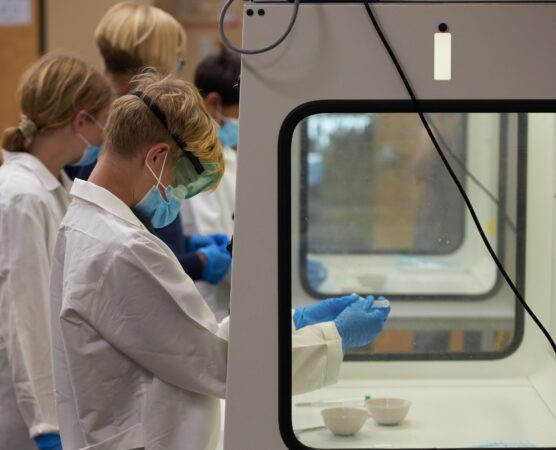The study of plants will soon never be the same for young minds at SCVi, iLEAD Agua Dulce and iLEAD Exploration, all part of the iLEAD Public Charter School Network in the Santa Clarita Valley. On Sunday, Nov. 5 the students’ experiments to determine whether certain plants can grow in space will be included as part of a SpaceX mission bound for the International Space Station.
“It was a remarkable and memorable experience to support the learner teams, led by their amazing facilitators, as they prepared the experiments that will be launched to the International Space Station,” said Kathleen Fredette, Director of STEAM (Science, Technology, Engineering, Arts and Math) Initiatives for iLEAD Schools. “This represents learners working together for over a year to accomplish this goal, to actually send something to space.”
Here is a chronology of the last leg of this long-awaited journey and the in-space experiment and post-flight analysis that will follow.
Four student teams from the three participating schools prepared unique experiments:
— A team from SCVi, a TK-12 school and the Founding School in the iLEAD Network, is looking to determine whether bok choy, an edible type of Chinese cabbage, will germinate and grow effectively in space.
— A team from iLEAD Exploration (an independent study program that also serves students in grades TK-12) seeks to determine the viability of growing Creeping Charlie plants (a kind of ground-ivy) in space.
— A team from iLEAD Agua Dulce (which currently serves grades TK-11 and will begin serving 12th graders in the fall of 2024) hopes to grow capsicum, a variety of red pepper, in space.
— A combined group of students from all three schools is collaborating to determine if they can grow yucca plants in space.
The student teams gathered in a science lab on Oct. 12-13 to load seeds and water for their plants into “Mixstix,” small tubes designed to house and transport experiments with exacting care at each step of the journey to guarantee their safe arrival on the ISS, successful in-space experimentation and return back to Earth for post-flight analysis.
The ambitious experiments are part of the ongoing iLEAD DreamUp to Space Design Challenge developed by iLEAD Schools and designed created to help NASA and the greater space exploration community determine the viability of humans colonizing the Moon and Mars.
“This is such a unique opportunity, as our students are not being asked to simulate or even replicate experiments previously conducted by ‘real scientists.’ Rather, they are the real scientists, designing and conducting these experiments on their own and in direct collaboration with SpaceX and NASA.,” said SCVi Codirector Martha Spansel-Pellico.
Now that each of the experiments is loaded properly, they will be shipped by aerospace service and hardware company Nanoracks to Florida’s Cape Canaveral, loaded onto an upcoming SpaceX mission and delivered to the ISS. After reaching space, NASA astronauts will carry out the experiment according to the students’ specifications. The return of the experiments is anticipated during an upcoming SpaceX mission, anticpated to be on or near Tuesday, Dec. 5. Following their return, students will promptly analyze the results of both experiments.
“I couldn’t be prouder of our kids and the iLEAD community,” Fredette said.
The seven schools and academic programs of the iLEAD Charter School Network serve five California counties: Los Angeles, Orange, San Bernardino, Ventura, and Kern. iLEAD’s vision is to personalize learning with a focus on project-based and social-emotional learning, inspiring lifelong learners with the skills they need to lead in the 21st century.
To learn more, please visit ileadschools.org or email info@ileadschools.org.
Like this:
Like Loading...
Related





 Tweet This
Tweet This Facebook
Facebook Digg This
Digg This Bookmark
Bookmark Stumble
Stumble RSS
RSS




























REAL NAMES ONLY: All posters must use their real individual or business name. This applies equally to Twitter account holders who use a nickname.
0 Comments
You can be the first one to leave a comment.